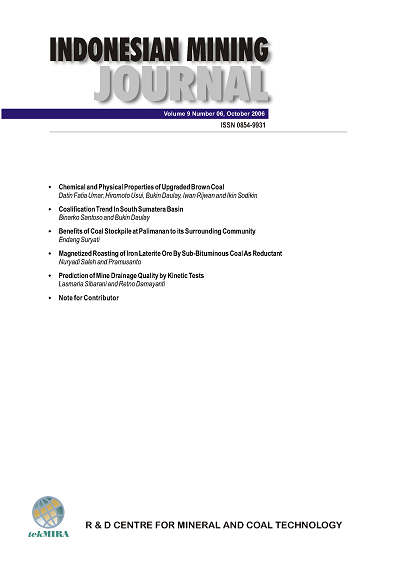Indexed by:
Vol. 9 No. 3 (2006): INDONESIAN MINING JOURNAL Vol. 09 No. 3 October 2006

Current edition of the journal is focused on coal, mineral and mining environment. Coal issues are still getting special portion. It is understandable, because Indonesia is endowed with abundant coal deposits that presumably are admissible energy consumption for 150 years ahead. A lot of aspects of the sources are significant to be studied in terms of solving problems as the real steps to support the development of coal-based energy sources in Indonesia. From now, Indonesia is at- tempting to strive for substituting fuel oil-based energy into coal-based energy. Chemical and physi- cal properties of Indonesian coals are appropriate in the upgraded brown coal (UBC) process, particularly in reducing moisture content and calorific value. In accordance with coal rank, simi- larities and differences in rank characteristics of the Bukit Asam coals indicate their geological setting, particularly influence of the andesitic intrusions. The higher rank of the coals is a result of higher regional coalification level in the basin. Coal stockpile in Palimanan is beneficial to sur- rounding communities due to increase of income and multiplier effect. However, its negative im- pact is present due to dust pollution from the stockpile and the transportation.
A paper related to developing mineral commodity from aspects of potential, processing technology and engineering is served in this issue. It discusses iron laterite ore. Limonite in laterite iron ore can be transformed into ferromagnetic product by using coal as reductant in rotary kiln. Then, the roasted product are concentrated using low magnetic intensity.
The last paper focuses on mine drainage issues. Acid mine drainage (AMD) is significant and expensive environmental concern in mining industry. It must be predicted prior to starting mining operation. A model of kinetic test is required to calibrate and validate the quality of AMD.
It is realised that all the above aspects are not totally discussed yet in this edition. However, it is expected that some of those papers could be a golden bridge to cope with the gap faced by those commodities in Indonesia, particularly between the industrial sectors and R&D institutions.
The Editor











